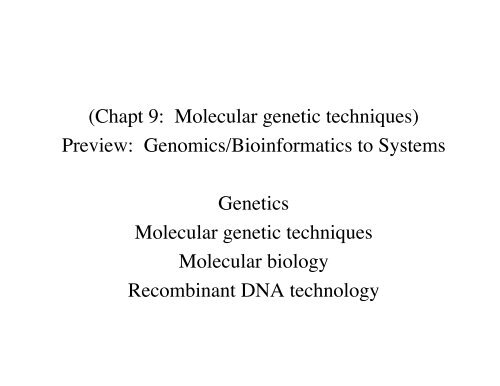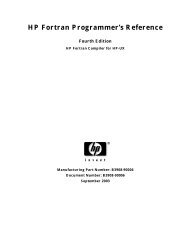Lecture 7 - Genome Tools
Lecture 7 - Genome Tools
Lecture 7 - Genome Tools
Create successful ePaper yourself
Turn your PDF publications into a flip-book with our unique Google optimized e-Paper software.
(Chapt 9: Molecular genetic techniques)<br />
Preview: Genomics/Bioinformatics to Systems<br />
Genetics<br />
Molecular genetic techniques<br />
Molecular biology<br />
Recombinant DNA technology
Fly genetics to fly molecular biology<br />
•WT<br />
•Dominant mutation (ey)<br />
•Suppressor mutation<br />
•Nature of… genetics v mol biol v biochem
Worm cell biology to molecular biology<br />
•RNAi can silence genes<br />
•Transgenic worm (right) with GFP reporter in head neurons<br />
•Expresses dsRNA to muscle gene unc-15<br />
•Degrades mRNA<br />
•Causes complete paralysis<br />
•Nature of… genetics v mol biol v biochem
Function, structure and location of gene products<br />
•Nature of… genetics v mol biol v biochem
Bacterial genetics: original expts in bacteria and bacteriophages
Bacterial genetics: original expts in bacteria and bacteriophages
into minimal medium---><br />
PREVIEW: Molecular biology and applications.<br />
<strong>Genome</strong> and manipulation of genome define organism<br />
(simple case)<br />
--> growth<br />
--> no growth
Molecular basis- metabolic pathways<br />
(simple case)<br />
•Example: genetics and biochemistry<br />
to molecular biology to Systems<br />
•Metabolic pathways<br />
•Lac operon<br />
•cis/trans
Molecular basis- metabolic pathways<br />
(simple case or complex case???)<br />
-albinism, 1:17,000<br />
-metabolic pathways<br />
-phenotype/genotype<br />
-affects entire organism<br />
--> simple or complex?
Genetic and molecular basis- metabolic pathways<br />
“simple case”<br />
•One gene, one mutation<br />
•DNA-> protein sequence<br />
•Two copies vs one copy<br />
•[Different from skin color]
Chemical basis- metabolic pathways<br />
“simple case”
Genetic and molecular basis- metabolic pathways<br />
“fish to human”<br />
•(What is the difference between a fish and a human?)<br />
•RLLamason…KCCheng. Sci310: 1782 (05)<br />
•SLC24A5, a putative cation exchanger, affects pigmentation in zebrafish and humans<br />
•Zebrafish pigmentation gene and human counterpart<br />
•One variant - natural selection for lighter skin in Europeans<br />
•But, 93% Africans and East Asians share same allele<br />
•“East Asians are usually light skinned too”- so, other genes?<br />
•“golden” zebrafish plus human SLC4A5 -> darker stripes (rescue)
•Epigenetic<br />
•Environmental<br />
•External<br />
•Internal<br />
•Expression and pools<br />
Molecular basis- metabolic pathways<br />
“simple case”<br />
But, more data leads to more questions…. complexity<br />
-Systems biology
•Very different heart structures
Molecular basis- developmental pathways<br />
“simple case”<br />
But, more data leads to more questions…. complexity TO SIMPLICITY<br />
•http://sandwalk.blogspot.com/2006/11/sea-urchin-genome-sequenced.html<br />
•http://scienceblogs.com/pharyngula/2006/06/modules_and_the_promise_of_the.php<br />
•0.5B years apart<br />
•Seemingly complex [they are!]
Molecular basis- developmental pathways<br />
“simple case”<br />
But, more data leads to more questions…. complexity TO SIMPLICITY<br />
•http://sandwalk.blogspot.com/2006/11/sea-urchin-genome-sequenced.html<br />
•http://scienceblogs.com/pharyngula/2006/06/modules_and_the_promise_of_the.php<br />
•0.5B years apart<br />
•Seemingly simpler [they are!]
Genomics/bioinformatics…. complexity TO SIMPLICITY<br />
•http://sandwalk.blogspot.com/2006/11/sea-urchin-genome-sequenced.html<br />
•http://scienceblogs.com/pharyngula/2006/06/modules_and_the_promise_of_the.php<br />
•ESodergren…RWright. Science, Nov 06<br />
•and The Sea Urching <strong>Genome</strong> Sequencing Consortium<br />
•Strongylocentrotus purpuratus<br />
•814Mb genome<br />
•A model for developmental and systems biology
From<br />
<strong>Genome</strong> and manipulation of genome define organism<br />
(complex case)
Leads to.......<br />
(‘The good, the bad and the ugly [?])’....
Leads to.......
<strong>Genome</strong> and manipulation of genome define organism<br />
(how)<br />
•Gurkin is sim to EGF; receptor is RTK •PIPE protein- sulfation of glycosaminoglycans<br />
•[attached to proteins- proteoglycans]- cell fates
•Activation of Toll by Spatzel leads to<br />
•Gradient of Dorsal:<br />
ventrally high and dorsally low.<br />
•[Dorsal] not high enough to bind to<br />
•low affin twist/snail; binds to<br />
•High affin rhomboid with activator bHLH.<br />
•Sharp boundary of Rhomboiddistinct<br />
cell types.<br />
•And....<br />
Spatzel binds Toll....
[visually] Flower development fn of spatially regulated txn factors
Complex, simple- same basis<br />
-It’s in the genome!
‘Baby’ genetics<br />
•terminology •Diploid/haploid<br />
•Dominant/recessive, alleles<br />
•What is a gene?
‘Baby’ cell biology: asexual reproduction
‘Baby’ cell biology: sexual reproduction
•Br/bl x bl/bl<br />
•F1: Br allele lost<br />
•random event<br />
Forces that cause populations and<br />
species to evolve<br />
CPurrington (Swarthmore)
Forces that cause populations and<br />
species to evolve<br />
•mutations can be<br />
•good- improves species fitness and/or reproductive success<br />
•bad- decreases “<br />
•neutral- no effect<br />
•[ugly- totally subjective... ‘only a mother...’]<br />
•basis for evolution via natural selection, which operates when there<br />
is variation caused by genetic differences<br />
CPurrington (Swarthmore)
What is a mutation? Molecular level
Segregation of alleles in yeast
Identification of gene, gene product (gp), pathways….<br />
-similar to bacteria… and viruses
<strong>Tools</strong> for genetics: conditional mutations
•cdc28 arrest pre-budding<br />
•cdc7 arrest at budding
Complementation: temperature sensitive mutants
Interacting or redundant proteins, compensating mutants<br />
•Nature of ‘rescue’ vs suppression<br />
•Temperature sensitive mutants<br />
•ACT1 actin<br />
•SAC6 actin-binding protein<br />
•WT: asymmetric distribution<br />
•Each mutant: random distribution<br />
•Dbl mutant: “WT-like”<br />
•(restores function, “suppresses”)
Recombinant DNA and<br />
molecular biology techniques:<br />
Paradigm shift.<br />
(and bioinformatics)
Molecular biology: recombinant DNA technology. Key technique<br />
•summer ‘71 SV40 DNA to E. coli- postponed<br />
•Feb ‘75 Asilomar Conference: most recombinant DNA work should continue, with safeguards<br />
•Sanctions could be severe
Host restriction (and modification): organism view
At the molecular level
Host modification
Palindromes:<br />
1) 55, 212, 1331, 45654<br />
2) pop, level, racecar<br />
3) Madam, I’m Adam<br />
Was it a rat I saw?<br />
A man, a plan, a canal,<br />
panama<br />
4) GGATCC<br />
CCTAGG<br />
Restriction enzymes and recognition sites
•Lambda repressor<br />
•EcoRV<br />
•http://en.wikipedia.org/wiki/DNA<br />
Restriction enzymes and recognition sites: DNA binding
Restriction enzymes and restriction sites: use 1
Construction of ‘ideal’ vectors
Construction of ‘ideal’ vectors: pUC series
RE, use 2: molecular cloning
Cloning into plasmids
Variations: cloning into eukaryotic hosts
Once you have a recombinant “genetic material,”<br />
Then what?<br />
Moving genomic elements into bacteria
Plasmid<br />
(Recombinant<br />
DNA)<br />
Phage<br />
Conjugation<br />
Moving DNA, mechanisms
Vector and insert size<br />
Vector type Insert Capacity Concerns Host<br />
M13 virus 1.5kb Bias of sequences E coli<br />
Plasmids 0.1-10kb Size instability bacteria, yeast<br />
Lambda phage 10-20kb Size limitation •Î/E.coli<br />
Cosmids 35-45kb Size limitation E coli<br />
P1 80-100kb E coli<br />
BAC 50-300kb E coli<br />
P1-BAC 100-300kb E coli<br />
YAC 0.1-2Mb Up to 60% chimera Yeast
Need for bigger inserts: Lambda phage vector
Larger inserts, eg, from euk genes: cDNA by reverse transcription<br />
•cDNA libraries reflect gene expression states<br />
•[using protein chemistry methods]
cDNA libraries in plasmids<br />
•cDNA libraries reflect gene expression states
Characterization of inserts: Nucleic acids hybridization<br />
[what do you have? how do you know?]<br />
•Discovery limted by:<br />
•Labels<br />
•Types and conditions<br />
•Probes<br />
•Specificity<br />
•Non-specificity
Hybridization to inserts within lambda genome
Characterization of inserts: Nucleic acids hybridization<br />
Edwin Southern 1975, “Southern blot”
Variations on Southern blotting<br />
•Combine with restriction enzyme digestion and gel electrophoresis<br />
•Northern blots<br />
•Western blots<br />
•Southwestern blots
RE digest, gel electrophoresis resolution, blot transfer, and<br />
Southern hybridization<br />
•PAGE, polyacrylamide<br />
•Vertical gels
Gel electrophoresis, blot and probe- in more detail<br />
•Agarose gels<br />
•Horizontal gels
Hybridization results: Comparison of signals, alternative labels<br />
•Southern: single copy INO2 gene<br />
•5 ug yeast genomic DNA with biotinylated cRNA probe<br />
•H3, R1, Sal1 digests, with one minute exposure<br />
•Biotinylation/streptavidin (nucleic aicds)<br />
•Digoxygenin/antidigoxygenin Ab (nucleic acids)<br />
•Color (alkaline phosphatase), ferritin, gold, chemiluminescent dye, fluorescent dye<br />
•Northern: TCM1 expression: 5, 2.5, 0.625, 0.313 and 0.156 ug yeast genomic DNA with<br />
•A/B: DIG-label; C/D: biotinylated; E: 32 P<br />
•Exposure times: A: 5’; B: 25’; C: 5’; D 25’; E: 72hrs
End-labeling- using biochemistry of cell<br />
•www.roche-applied-science.com/PROD_INF/MANUALS/DIG_MAN/Dig12-18.pdf<br />
•Can be difficult to make-<br />
•Clone, amplify, purify, label, clean, use<br />
•Kinase end-labeling<br />
•Fill-in end-labeling
•http://www.ncbi.nlm.nih.gov/books/bv.fcgi?rid=hmg.figgrp.464<br />
Labeling by in vitro synthesis: multiple ways<br />
•Nick translation labeling<br />
•Random primed labeling
•http://www.ncbi.nlm.nih.gov/books/bv.fcgi?rid=hmg.figgrp.467<br />
Alternative labeling protocols
Zoo blots: Comparative genomics, pre-genomes<br />
•Defined highly conserved sequence, 250 bp CSB probe ( 32 P)<br />
•Low stringency: 2xSSC/50C/15min<br />
•Higher stringency: 1xSSC/50C (-chicken and -xenopus)<br />
•Higher stringency: only primates left<br />
•ca. late 1980s
Zoo blots: Comparative genomics, pre-genomes<br />
•http://opbs.okstate.edu/~melcher/MG/MGW4/MG412.html<br />
•vs “BLAST”
Second generation nucleic acids probes<br />
through oligonucleotide synthesis<br />
•Inorganic chem<br />
•Automation
•Synthesis of poliovirus from oligos<br />
•“Driven by “strong curiosity”<br />
•Not using a “natural” template<br />
•Assembled DNA<br />
•Transcribed into RNA ss genome<br />
•Self-replicates<br />
•5,700 bp<br />
•[social and political ramifications]<br />
•[no cure for poliomyelitis]<br />
•JCello et al. Sci 297:1016 (2002)<br />
Synthetic genomics<br />
•JCVenter: “irresponsible”, “inflammatory without scientific justification”<br />
•Ditto:<br />
•HOSmith (70s) and CAHutchinson (60s) - all-ighters to creat genome of phi-X174 (5386 bp)<br />
•…Venter. PNAS 100:15440. 2003<br />
•“Minimal microbial genome needs just 271 genes”<br />
•KKobayashi, et al. PNAS 100:4678 (2003)<br />
•http://www.genomenewsnetwork.org/articles/07_02/polio_create.shtml
Biochemistry techniques into molecular biology techniques:<br />
Bridging protein and DNA elements<br />
Characterizing genes and recombinant elements,<br />
and gene products (gps)
Analysis of DNA-binding protein<br />
Identical three SDS PAGE lanes<br />
•1- Silver stained yHSTF<br />
•2- Western: anti-yHSTF MAb<br />
•3- Southwestern: HSE<br />
->Three different purposes of assays
Northern blot analysis: increased expression of β-globin mRNA<br />
in differentiated erythroleukemia cells<br />
•UN= uninduced<br />
•Induced to stop growing,<br />
to differentiate<br />
•1000x increase at 96 hr
Over-expression in E. coli<br />
Western blot assay<br />
•A1: uninduced in E. coli<br />
•A2: induced in E.coli<br />
•A3: positive control<br />
DNase I footprinting assay<br />
•B1, 10: no protein<br />
•B2, 3: pure HSTF<br />
•B4, 5, 6: uninduced crude<br />
•B7, 8, 9: induced crude<br />
•Very high resolution of binding
Deletion analysis of binding domain<br />
Localization of binding domain:<br />
Deletion analysis and SW assay<br />
•A1- 3926 native<br />
•A other lanes- 3’ endpoints of deletions<br />
DNase I footprinting assay<br />
•B1, 18: no protein<br />
•B2, 3: pure HSTF<br />
•B4: uninduced native<br />
•B5, 6, 7, 8: induced native<br />
•B9: uninduced deletion 1<br />
•B10, 11: induced deletion 1, two levels<br />
•B12: uninduced deletion 2<br />
•B13, 14: induced deletion 2, two levels<br />
•B15: uninduced deletion 3<br />
•B16, 17: induced deletion 3, two levels
Over-expression in S. cerevisiae<br />
Galactose-induced overexpression GAL-HSF1 fusion<br />
•GAL1/GAL10 promoter+HSF1<br />
•cotransformed with UAS HSE replacing UAS CYC -lacZ<br />
A- galactose<br />
B- glucose<br />
‘blue= lacZ gene on’
Genomics<br />
and the ‘new’ Big biology<br />
“discovery science”<br />
Recombinant DNA technology<br />
genomes, esp human<br />
human disease genes<br />
“next” lecture [8]: <strong>Tools</strong> and tools development<br />
Applications and ‘new’ applications
Complementation: metabolic intermediate mutants
Examples of pathway mutations and pathway dissections:<br />
Genetics to biochemistry<br />
•In same pathway<br />
•Intermediate accumulate preceding mutation step
Use of double mutants to order steps in biosyn path<br />
•In same pathway<br />
•Intermediate accumulate preceding mutation step
Use of double mutants to order steps in signal path<br />
•Analysis works if the two mutations have opposite effects<br />
•Define constitutive vs basal levels
















